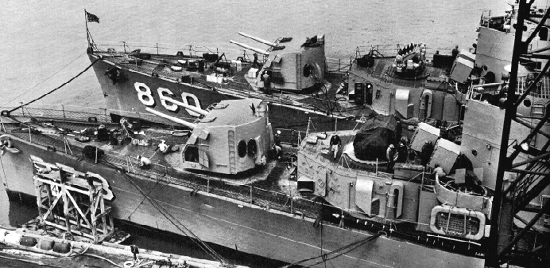
|
|
| ||||||||||||||||||||||||||||||||||||||||||||||||||||||||||||||||||||||||||
Fred T. Berry, Keppler, Lloyd Thomas, McCaffery and Norris underwent FRAM II conversion at a total cost of $ 22,500,000 in FY 1962 | |
Carpenter and Robert A. Owens underwent FRAM I conversion at a total cost of $ 15,400,000 in FY 1965. |
CARPENTER CLASS DESTROYERS |
||||
Name of Ship |
Hull No. |
Builder |
Launched |
Stricken Date |
FRED T. BERRY |
858 |
Bethlehem Steel, San Pedro |
28 Jan 1945 |
15 Sept. 1970 |
CARPENTER |
825 |
Consolidated Steel/ completed by Newport News |
30 Dec. 1945 |
20 Feb. 1981 |
HARWOOD |
861 |
Bethlehem Steel, San Pedro |
24 May 1945 |
1 Feb. 1973 |
KEPPLER |
765 |
Bethlehem Steel, San Francisco |
24 June 1946 |
1 July 1972 |
McCAFFERY |
860 |
Bethlehem Steel, San Pedro |
12 April 1945 |
30 Sept. 1973 |
NORRIS |
859 |
Bethlehem Steel, San Pedro |
25 Feb 1945 |
1 Feb. 1974 |
ROBERT A. OWENS |
827 |
Bath Iron Works, Bath ME |
15 July 1946 |
6 Aug. 1987 |
LLOYD THOMAS |
764 |
Bethlehem Steel, San Francisco |
5 Oct 1945 |
12 Oct. 1973 |
![]()
CARPENTER CLASS DESTROYER SPECIFICATIONS AFTER FRAM |
|
Displacement: |
Carpenter and Robert A. Owens: 2,500 tons standard (3,550 tons full load) Other Six: 2,425 tons standard (3,500 tons full load) |
Dimensions: |
390 1/2 x 41 x 19 feet |
Guns: |
Carpenter and Robert A. Owens: 1 qty, TWIN 5 inch/38 caliber MK 38 Gun Mount
installed at forward mount (Mount 51)
|
Weapons: |
Trainable hedgehog. 6 homing torpedo tubes (2 Triple mounts). 2 qty, DASH HelicoptersCarpenter and Robert A. Owens also received MK-112 ASROC launcher |
Machinery: |
2 Westinghouse turbines coupled to 2 DeLaval locked-train double reduction gears. 2 shafts, 350 RPM, SHP: 60,000 = 34.5 knots |
Boilers: |
FOUR Babcock & Wilcox working pressure 565 PSI at 850 degrees F |
Oil Fuel: |
4,647 barrels NSFO and 167 barrels of Diesel Oil = 650 tons |
Radius: |
At 2,425 tons standard maximum speed is 34.5 knots with endurance of 6,500 miles at 15 knotsAt 3,479 tons full load maximum speed is 31.3 knots with endurance of 5,370 miles at 15 knots |
Complement: |
Allowance: 264 (14 officers, 250 men) Accommodation for 21 officers, 270 men. |

USS McCaffery (DD-860) undergoing DDK conversion along side USS Fred T. Berry (DD-858). Shown at Mare Island Navy Yard on April 28, 1949
![]()
![]()
|
The name "Gyrodyne" in its stylized
form above, is the Trademark of and owned by the Gyrodyne Helicopter Historical
Foundation; unauthorized use is PROHIBITED by Federal Law. All Photographs, technical specifications, and
content are herein copyrighted and owned exclusively by Gyrodyne Helicopter
Historical Foundation, unless otherwise stated. All Rights Reserved
©2013. |